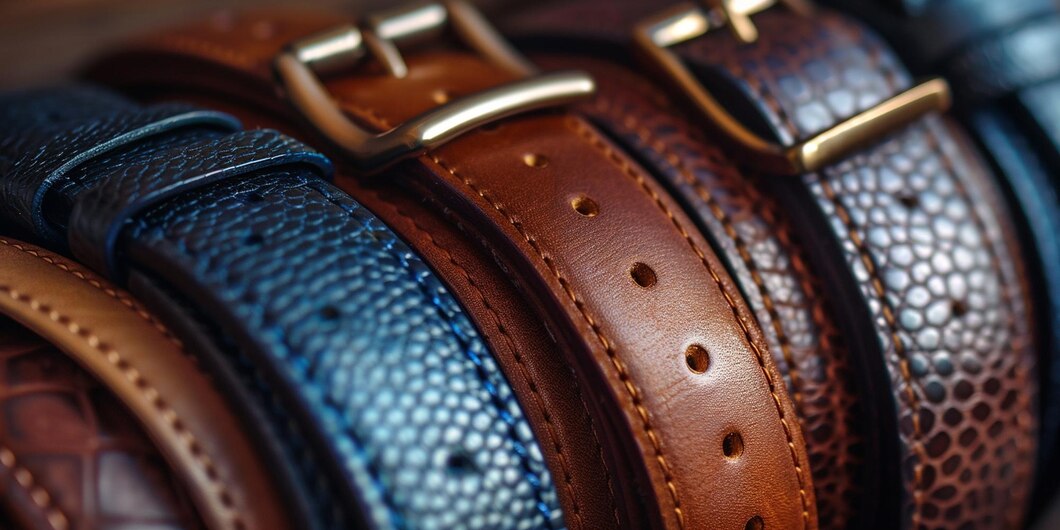Beyond being a practical item, leather belts are a fashion statement, a testament to workmanship, and an expression of individual preference. With so many different leather varieties available, it might be difficult to choose the appropriate one. We'll go over the primary kinds of leather belts, their benefits and drawbacks, and why cowhide leather belts are some of the greatest leather belts available in this article.
Additionally, we'll spotlight our favorite three leather belts from Belt Rhinestone's high-end line.

1. Cowhide Leather Belts
Overview: The most popular kind of leather for belts is cowhide, which is prized for striking a balance between softness, affordability, and longevity.
Pros:
- Extremely strong and resilient.
- Maintains shape while becoming softer with usage.
- Simple to maintain.
- Less expensive than exotic leathers.
Cons:
- Heavy compared to other leathers.
- To avoid drying, it has to be conditioned sometimes.
2. Calfskin Leather Belts
Overview: Young cattle skins are used to make calfskin, which has a smoother, more elegant finish.
Pros:
- A remarkably soft texture.
- A sophisticated, refined appearance for formal attire.
- Comfortable and adaptable
Cons:
- Less resilient than cowhide that is full-grain.
- It might cost more.
3. Oil-Tanned Leather Belts
Overview: Oil-tanned leather is given a tough, weather-resistant finish by applying natural oils to it.
Pros:
- Exceptionally strong and resistant to water.
- Vibrant, rich hues that get better with age.
- Low maintenance
Cons:
- Bulkier and heavier than formal leathers.
- Less appropriate for formal attire; more relaxed.
4. Exotic Leather Belts (e.g., Alligator, Ostrich)
Overview: Exotic leathers, which are made from rare animal hides, have unique patterns and a high-end appearance.
Pros:
- Various designs and textures.
- An extravagant statement item.
- Extremely resilient with the right maintenance
Cons:
- Quite costly.
- Needs specific care products.
5. Suede Leather Belts
Overview: Produced from the napped, velvety underside of the cover.
Pros:
- A smooth, fashionable texture.
- Perfect for casual attire.
- It is flexible and light.
Cons:
- Not as resilient as smooth leathers.
- More susceptible to moisture damage and discoloration.
6. Top-Grain Leather Belts
Overview: Slightly sanded or buffed to eliminate flaws and provide a clean finish.
Pros:
- More reasonably priced than full-grain.
- Enhanced softness and flexibility.
- Consistent appearance and texture
Cons:
- Not quite as robust as full-grain.
- It might not get the same deep patina.
7. Full-Grain Leather Belts
Overview: Full-grain leather, which is made from the uppermost layer of the hide, keeps its natural grain for optimal strength.
Pros:
- Ages wonderfully and is really durable.
- Over time, a distinctive patina forms.
- Not susceptible to deterioration.
Cons:
- More costly than other types of leather.
- Until broken in, it may initially be rigid.
What Makes Cowhide Leather Unique?
Although each kind of leather belt has its own allure, cowhide leather is among the greatest for daily use since it provides the ideal balance of value, style, and durability. It is a multipurpose wardrobe essential that looks good in both professional and informal settings.
Belt Rhinestone's Top 3 Best-Selling Leather Belts
1. Miller Men’s Belt – Italian Calfskin Genuine Leather Designer Dress Belt

Stylish and adaptable, ideal for both informal and professional settings.
2. Armando Men’s Dress Belt – Solid Brass Buckle Italian Calfskin Leather Belt

Timeless elegance with a classic design and a high-quality brass buckle.
3. Waco Texas Star Conchos Belt – Oil-Tanned Genuine Leather Ranger Belt

Rugged, Western-inspired design with prominent star conchos.
Discover your ideal fit by perusing our whole leather belt collection if you're searching for the greatest belts that blend comfort, style, and quality.


